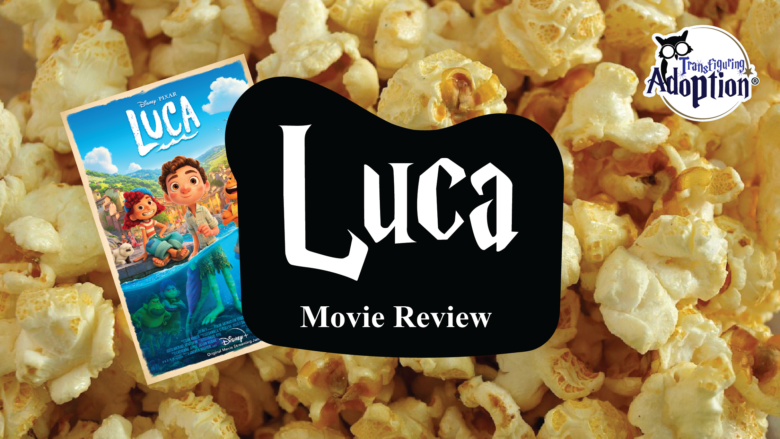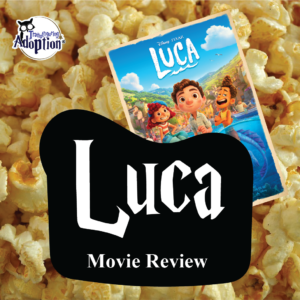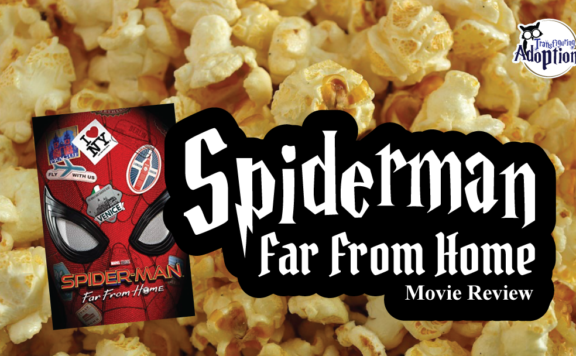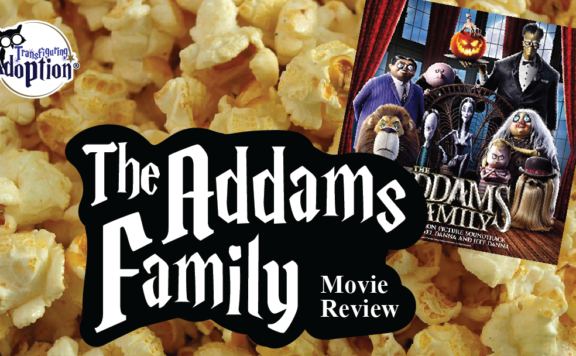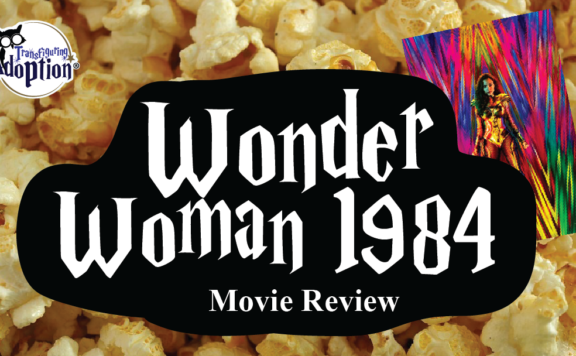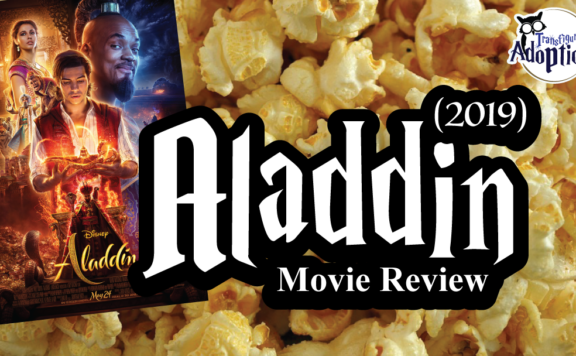Grade:
Transfiguring Adoption awarded this movie 4 Hoots out of 5 based on how useful it will be for a foster/adoptive family. [Learn more about our Hoot grading system here]
Movie Info:
-
Rating: PG (Rude Humor, Language, Brief Violence, Some Thematic Elements)
-
Genre: Kids & Family, Animation
-
Runtime: 100 minutes
-
Studio: Pixar Animation
From the Cover of Luca (2021) by Pixar Animation:
“Set in a beautiful seaside town on the Italian Riviera, Disney and Pixar’s original feature film Luca is a coming-of-age story about one young boy experiencing an unforgettable summer filled with gelato, pasta and endless scooter rides. Luca (voice of Jacob Tremblay) shares these adventures with his newfound best friend, Alberto (voice of Jack Dylan Grazer), but all the fun is threatened by a deeply-held secret: they are sea monsters from another world just below the water’s surface.”
Transfiguring Adoption’s Overview:
Luca (2021) starts out strangely reminiscent of The Little Mermaid—a sea creature is fascinated with human culture and longs to experience it for themselves. However, Luca quickly finds its own legs (pun intended) and is an original story about friendship and shares the message that our similarities are much more important than our differences and that the family we find can be just as meaningful as the family we’re born into.
The movie is colorful and fun, with minimal harmful triggers and is likely suitable for all ages and one that the whole family can enjoy together!
** Spoilers Could Be Ahead **
How Is This Relevant To Adoption & Foster Care?
Luca does not specifically address foster care or adoption. However, there is a character whom we learn was abandoned by his father and is eventually taken under the wing of another family. There are also many themes that children who have experienced trauma may relate to. The three main characters (Luca, Alberto and Giulia) all feel like they’re different and don’t fit, and are even bullied because of it. Many foster/adoptive children feel this way, especially when they are in a new home or school where they don’t know anyone. They will likely empathize strongly with these main characters. Additionally, Luca and Alberto are sea creatures who have disguised themselves as humans and are in a constant state of worry about being discovered. This can feel very similar to the way our foster/adoptive youth may feel like they have to hide their past of being adopted or in care for fear of being rejected.
Discussion Points:
- “Silenzio Bruno!” (Silencing Negative Inner Voice)
Early on in the film Luca expresses some fear about trying new things and Alberto tells him to say, “Silenzio Bruno!” whenever he feels this way as a way to drown out his self-doubt and negative inner voice. Luca takes this catchphrase on and frequently says it to himself whenever he is doing something that makes him a little bit nervous. Of course, we don’t want our children to silence the voice that tells them riding a poorly-designed Vespa down a steep cliff is a bad idea, as Luca does. However, negative self-talk can be incredibly damaging and is very common in children who have experienced abuse. Children who have been through trauma tend to have poor self-esteem and self-worth. This, often combined with anxiety, leads them to not try new things because they worry they aren’t good enough and convince themselves they can’t do it. This catchphrase can be a fun way to help them counteract their negative self-talk. They could use this phrase or even pick something else. Help them practice saying their catchphrase anytime they feel negative thoughts about how they can’t do something, or aren’t good enough, just like Luca does throughout the movie. - Accepting Differences
In a bit of an amusing dichotomy, we have sea creatures who are afraid of the ‘land monsters’ and humans who are afraid of ‘sea monsters. This is a great illustration that most of the time we assume things will be scary because we don’t know or understand them, but eventually realize that we had nothing to be afraid of once we get to know them. The same principle is demonstrated here—as Luca and Alberto live among the humans, they realize that they aren’t the scary monsters they’ve been led to believe. And when Luca and Alberto are eventually exposed as sea creatures, the humans initially react with fear and mistrust but then realize that the sea creatures mean them no harm and they were all afraid for no reason. This can be a great catalyst for discussing diversity and that just like in the movie, it is our similarities that matter much more than our differences, and that everyone deserves love and acceptance rather than fear or hate. Another great example is in the character of Massimo, Giulia’s father. He only has one arm, but this is not his defining characteristic and is not even dwelled on tremendously in the movie. It’s just who he is and his disability doesn’t limit his life. Alberto asks him about it at one point and he simply says that he was born that way and all the characters accept it and move on. - Navigating Friendship Dynamics
Youth from a background of trauma often struggle to make friends. They’ve likely moved homes and schools multiple times and often have challenging behavioral issues as a result of their trauma. In addition, they may not have had a lot of positive relationship behavior modeled for them. All of these factors together lead to a huge struggle to establish and maintain friendships. In this movie we see a trio of friend’s form: Luca (a sea creature who longs to experience human life), Alberto (a sea creature who has been abandoned and alone for many years), and Giulia (a young human girl who is very into science and ostracized by her peers). The road to friendship is a bit rocky—while Alberto and Luca become best friends very quickly, they clash with Giulia initially but end up banding together due to a shared goal to win the triathlon. This is a great opportunity to talk about how the group forms a friendship based on shared interests and the ways they nurture and grow their relationships together. Another great aspect of this to talk about is the concept of jealousy within friendships. Luca and Alberto are initially inseparable and Giulia is more of an outsider to the pair. However, Luca and Giulia begin to bond over their shared interest in science and Alberto begins to feel jealous and left out. However, in the end he is able to resolve these feelings and even helps Luca go away to school with Giulia. Even though he will miss him, he wants what’s best for his friend. So not only do we get to see how a friendship forms and grows, but the ways in which characters resolve the natural conflicts that occur within any relationship. This should provide lots of opportunities for discussion! - Healthy Goodbyes
At the end of the movie, Alberto realizes that he and Luca have different dreams and that to be a supportive friend they have to go their separate ways for a while. Luca goes away to school with Giulia so he can learn and discover the world and explore his passions. Alberto stays in Porto Russo with Giulia’s dad who has agreed to take him in and teach him to be a fisherman. What Luca needs most in this moment is to get out into the world and experience new things. And what Alberto needs is the stability and security of being part of a family after being on his own for so long. Alberto is able to recognize and accept this, even though it means a separation from his friend. For children in foster or adoptive situations they often don’t have a chance to experience a healthy goodbye and rather experience sudden and traumatic displacement sometimes without any chance to say goodbye at all. Separations are a normal part of life for all of us, so it’s important to model what a healthy one looks like, so that children know that saying goodbye doesn’t always have to be traumatic. This is a great opportunity to discuss how to engage in a healthy goodbye with loved ones.
Cautionary Points:
- Maladaptive Parenting/Survival Behavior
Luca has a very overprotective mother. Every time Luca mentions humans or wanting to travel to the surface, his mother tells him that they’re murderers or he’s going to die. Now, she has valid reasons for these concerns but the way in which she approaches these concerns with her son is problematic and likely contributes to the anxiety he experiences. After she discovers that he disobeyed her, she tells him he’s being sent to live with his somewhat creepy uncle ‘for his own safety’, though this clearly scares Luca and feels more like punishment than protection. - Lying
Luca lies to his parents several times in order to visit the surface and spend time with his friend Alberto. While this is only a minor plot point, it reinforces the idea that lying to caregivers in order to do a forbidden activity is okay. For many children who have experienced trauma, they don’t trust adults and may already be prone to lying to them, so seeing this portrayed on screen with minimal consequences may be problematic. - Unrealistic stunts/Peril
This is most obvious in the scene where Luca and Alberto are building their ‘Vespa’ and racing it down the hillside. The movie employs what is affectionately referred to as ‘Disney Physics’: things that should be impossible aren’t and no one ever gets hurt doing the stunt. Unfortunately, in the real-world riding a wood-and-nail Vespa down a steep hillside into an ocean full of sharp rocks would be incredibly dangerous. There are also a number of other instances where the children engage in perilous stunts that should not be attempted in real life, but may be tempting for those with poor impulse control to attempt to reenact. - Running Away
After his parents find out he’s been visiting the surface, they tell Luca that he’s being sent to live with his uncle in the Deep Ocean. This frightens Luca, as does the thought that he’ll never see Alberto again. So, in response Luca runs away with Alberto to the human lands, putting himself in danger. However, Luca makes friends with Giulia and her family and ends up having a great time. This may glorify running away to children who are prone to that behavior. - Bullying
There is a LOT of bullying throughout the film. The other children in the village are very cruel to Giulia and also make fun of Luca and Alberto when they first arrive, saying they smell and teasing them about their clothing. These are likely to be sensitive subjects for children who have experienced trauma, as bullying is frequent among this demographic, especially relative to being ‘different’. The primary instigator of this bullying is Ercole. It’s not clear whether he’s an adult or just a much older teen but it’s extremely uncomfortable the way he continuously harasses the young children. - Weapons
Giulia’s father is a fisherman. He has harpoons hanging in his house and we see him using a large meat cleaver to cut fish. However there is a scene where he turns to face Luca and Alberto still holding the knife which has blood on it. When Luca and Alberto are revealed as sea monsters they have harpoons pointed at them threateningly, though no harm comes to them. - Mild Child Endangerment
After Luca runs away with Alberto, his parents follow and try to find him to bring him home. However, since everyone looks different on land than they do in the ocean, they aren’t sure which child is theirs. In an attempt to locate him, they find ways to expose children to water as that turns them back into sea creatures. In some cases, this is as harmless as a water balloon or glass of water splashed on them. But on a few occasions a child is pushed into a fountain or even the ocean. While this is done as a humorous gag, and no child appears to come to any actual harm, watching two adults push children off walls or into the water may be upsetting to children who have been abused or have a fear of water/drowning. - Mentions of Divorce
Giulia briefly mentions that her parents are separated and she alternates living with her mom and her dad. There aren’t any negative connotations from the mention, though it might be upsetting for children currently adjusting to a divorce or other situation where they frequently move between homes (such as between biological and foster caregivers.) - Abandonment by Caregiver
We learn that Alberto’s father left one day and never came back. It’s an emotional scene and we see a calendar where Alberto has been marking off the days waiting for his return. He also tells Luca, “You’re the good kid and I’m the kid that ruins everything.” This scene is likely to be difficult to watch for children who have experienced abandonment by caregivers or who identify with Alberto and his belief that he is responsible for ruining his family. - Emotional Goodbyes
Luca leaves with Giulia to go away to school and Alberto stays behind. Luca wants to go to school and learn and see the world and so he leaves with Giulia. Alberto is not interested in school the way the others are and what he needs is a family- which he has found with Giulia’s father who is training him to be a fisherman. It’s a healthy goodbye for everyone involved as they all understand that they have different needs/wants and are supportive of one another’s dreams. However, it’s still a very emotional scene as the friends say goodbye both to one another and to their respective parents. This may be especially emotional to watch for children who have recently experienced a separation from family members or friends.
Discussion Guide:
- Why do you think Luca’s parents are so opposed to his interest in the human world? How do they express their concern? Do you think there was a better way they could have approached this?
Caregiver Note: At the beginning of the movie we see Luca collecting small treasures left behind from the humans and asks his parents questions about what it’s like on the surface. Luca’s mother repeatedly refuses to talk about it, instead just telling him that he shouldn’t be interested in them because they’re murderers and if he goes on land they will kill him. At this point Luca’s simply curious and interested in learning more. Instead of discussing his interest, why it’s important to him and finding a way for him to explore it safely, his mom simply forbids it, shutting him down. As most parents of teenagers know, telling them they can’t do something seems to only make them want to do it more. Had she been willing to sit down with Luca and have an open dialogue about his passions and calmly explain her reasons for concern, perhaps things would have turned out differently. While a blanket ‘because I said so’ may work for very young children, Luca appears old enough here to participate in a meaningful conversation and rules and the reasons behind them. Certainly not blaming the mom for his choices to lie and run away, but having this conversation with your kids may be a way to both reflect on your own parenting approach and hear their ideas about what approach might work best for them. It also seems that his mother unintentionally exacerbates Luca’s anxiety with her constant mention of danger, which is something he has to overcome throughout the movie. - What does Alberto mean when he tells Luca he ‘has a Bruno in his head’? Do you ever feel like you have a Bruno in your head?
Caregiver Note: After Alberto and Luca build their Vespa, Alberto wants to race it down the hillside but Luca is hesitant, worrying about danger. While a healthy dose of caution is always advisable, Luca seems to get hung up easily on his own self-doubts and worry. Alberto tells him when this happens to simply say ‘Silenzio Bruno!’ to quiet the negative voice in his head. Throughout the movie Luca uses this technique as a way to help him find his inner bravery when trying new things or doing something he’s nervous about. While of course we don’t want our children careening down a mountain on a poorly built bike and diving into the ocean as the boys did here, finding strategies for overcoming negative inner dialogue is a great thing! We all have that little voice in our head that sometimes tells us we aren’t good enough or can’t do something. Children who have experienced trauma likely have a great deal more of this than the average child—maybe someone they loved told them they were worthless either in words or in the way they were treated. Giving that negative voice a name and being able to tell it to ‘be quiet’ is a great way of illustrating this concept to children and may be a strategy they can adopt.
- Activity: Silenzio Bruno
Caregiver Note: Going along with the above question, spend time with your child coming up with their own catchphrase to counteract negative self-talk. Maybe they want to use “Silenzio Bruno” like Luca and Alberto or maybe they want to come up with their own name or phrase. Help them choose something that works for them. Then write that phrase on a small index card that can be taped somewhere the child sees regularly: their mirror, inside their backpack or notebook, etc. They can decorate the card however they like! Make more than one if they feel like they would like more frequent reminders. This way each time they see their card it will be a friendly and subtle reminder to tell that voice of anxiety and self-doubt to back off!
- Why does Luca run away? Do you think this was a good choice?
Caregiver Note: When Luca’s parents find out he has been sneaking off to the surface to spend time with Alberto they get angry and concerned about him. His mom arranges for him to go and live with his uncle who lives in the Deep Ocean. This frightens Luca both because of the location he’s being forced to move to and the fact that it will mean never seeing his friend again. This situation may feel familiar for children who have been through foster care. They were removed from living with their parents and sent somewhere strange and unfamiliar, often being forced to leave behind their siblings or friends. Luca’s mom tells him it’s to ‘keep him safe’ which is often the reason given to children when they are removed. And while this is true, it doesn’t help the situation feel any less stressful or upsetting. Many will likely sympathize with Luca’s choice to run away. This can be a great opening for a conversation about your child’s own similar experiences and also discuss ways in which his parents might have been able to make the transition easier on him, and the ways you could help make their transition easier. Maybe there’s a way to stay in touch with siblings or friends from their previous home. Or maybe it’s cooking a favorite meal they used to eat or something else that reminds them of ‘home’.
- When Alberto and Luca first meet Giulia she says, ‘I race alone’. How do they end up being such good friends when they initially weren’t sure about each other?
Caregiver Note: While Luca and Alberto initially become friends very quickly, it takes longer with Giulia. They end up uniting over a shared cause—they all want to win the triathlon and are also united against a common enemy, the town bully Ercole and his gang. As they spend time together then end up all growing into close friends and Giulia even invites them to stay with her and her father. Foster and Adoptive children often struggle to make friends. This is due in part to the fact that they have likely moved homes multiple times. Additionally, as a result of trauma children may have challenging behaviors or difficulty understanding social cues. And depending on the abuse or neglect they might have experienced, they may not have had healthy relationships modeled for them so they don’t have an understanding of how to form healthy relationships of their own. This question can be a way to start a conversation about how to make friends and nurture those friendships. Shared interests can be one of the easiest ways to do so. Maybe there is a club, team, or activity your child(ren) can join that will allow them to meet other kids that share goals or interests with them, like this trio does with their triathlon team.
- Which of the three friends do you identify with the most? Why?
Caregiver Note: Each of the three friends (Luca, Alberto, and Giulia) bring their own unique personalities and struggles to their friendship. Talking about which of them your child most identifies with may offer a lot of insight as to what they might be struggling with. Luca has a lot of anxiety about trying new things. Alberto is guarded and still hurt from being abandoned by his father and being alone for so long. Giulia enjoys school and reading and is made fun of by the other children for being different. She also mentions that her mom thinks she’s “a bit much”. All of these issues are things our kiddos might be struggling with so in talking about the characters’ personalities and challenges it can be a safer way to discuss their own.
- Is Giulia’s father a good caregiver? Why or why not?
Caregiver Note: Mr. Marcovaldo (Giulia’s father) is an exemplary caregiver. When Luca and Alberto come home with Giulia the father takes them in without a question, despite their somewhat strange behavior. He never once asks questions but provides them with food and shelter and even hires them to help with his fishing business when they need to earn money for the race. He quietly accepts them and treats them like family because they are friends with his daughter. When Alberto runs away, he immediately goes out to look for him, even though it means missing dinner. When Luca says he doesn’t think Alberto wants to be found Mr. Marcovaldo responds that he’s going to go anyway ‘just in case’. When everyone is calling Luca and Alberto monsters after we see they’re sea creatures Massimo stands up for them without a second thought. He even takes Alberto in at the end when Luca and Giulia go away to school. This is a great opportunity to have a conversation about what qualities make a good caregiver and how you can best be supportive of them. - Why do you think Alberto starts being so mean to Luca? What would have been a better way for him to handle his feelings of jealousy?
Caregiver Note: Initially it’s just Luca and Alberto, a pair of best friends ready to take on the world and have adventures together. Then they meet Giulia and she is added to the group of friends. At first everything is fine but Alberto notices that Luca and Giulia are growing closer due to their shared interest in books and learning. He grows jealous, feeling left out and starts acting out, saying and doing mean things. Eventually he fights with Luca and ends up running away. Luca finds him but Alberto pushes him away. The pair does eventually make up and Alberto realizes that just because he and his friend have different interests and their paths might go different directions that doesn’t make their friendship any less. This can be an opportunity to talk with children about their own experiences with jealousy and strategies for handling it if it comes up in the future—such as talking about their feelings instead of acting out. - While in the human world Luca and Alberto have to live in a constant state of worry that someone might discover who they really are. How do you think this affects them? Have you ever felt like that?
Caregiver Note: We all have parts of ourselves we hide from others, parts that we think will make others reject us if they were to find out who we really are. This is especially true for youth who have experienced trauma. Many do not wish for others to find out they are in foster care and put a lot of energy into hiding this. Other examples could be their sexual identity, socioeconomic status, religion or a whole host of other things. Luca and Alberto are in a constant state of anxiety worrying about being discovered and utilize a tremendous amount of energy to hide their true selves from everyone. Talking about their struggles might be a great way for youth to open up about their own similar struggles and how they feel when they have to hide parts of themselves vs. when they can relax and be themselves.
- At the end of the movie Alberto gives Luca a train ticket to go away to school with Giulia. Why do you think he made this decision? How do you think it made him feel to say goodbye to his friend?
Caregiver Note: Sometimes we have to leave those we love, but it’s okay. Luca needed to go to school and learn and explore his passions. And Alberto needed stability and a family after being alone for so long. While this is a very emotional scene it’s also a great example of a healthy goodbye. We see Alberto grow past his jealousy and recognize that just because he and Luca had different interests and their paths are going to go separate ways for a time, it doesn’t mean they mean any less to one another. This can be a great learning opportunity to discuss healthy goodbyes with youth and the idea that just because someone might not always be with them physically, it doesn’t make those bonds any less meaningful or important.
About the Author: Jenn Ehlers
Jenn is a central Virginia native who received her BA in Psychology from the University of Virginia in 2012. Since then she has worked for a local mental health agency and the Department of Social Services in various capacities and has been involved in her community’s efforts to create a Trauma Informed Network. Currently Jenn works in vocational rehab and mentors youth in foster care. When she isn’t working, Jenn enjoys writing stories, anything and everything Harry Potter, and spending time with her niece and nephew.
**Transfiguring Adoption is a nonprofit organization seeking to nurture growth in foster and adoptive families by giving a HOOT about their families. Transfiguring Adoption does not intend for its reviewers nor its review to be professional, medical or legal advice. These reviews and discussion guides are intended to help parents to better be able to connect and understand their children who come from traumatic backgrounds.
